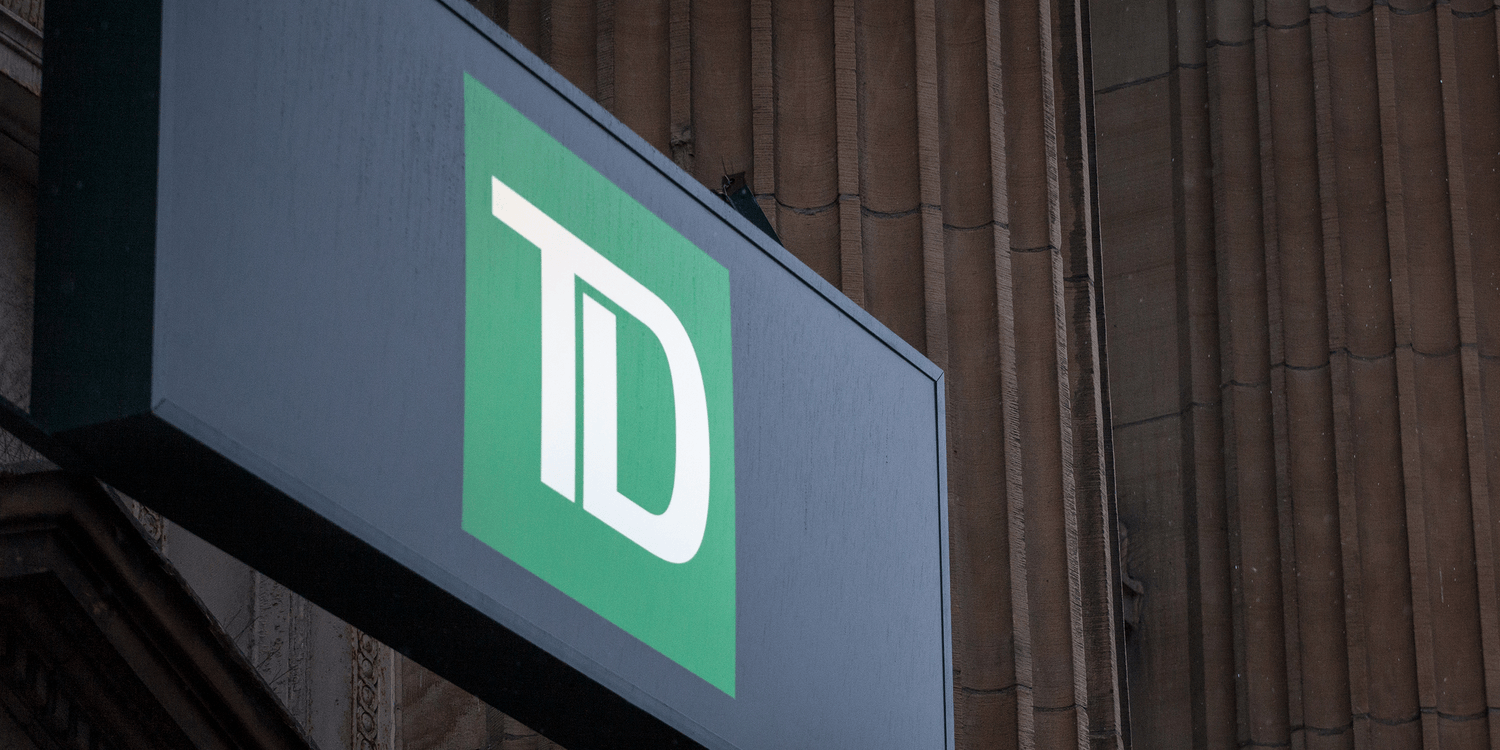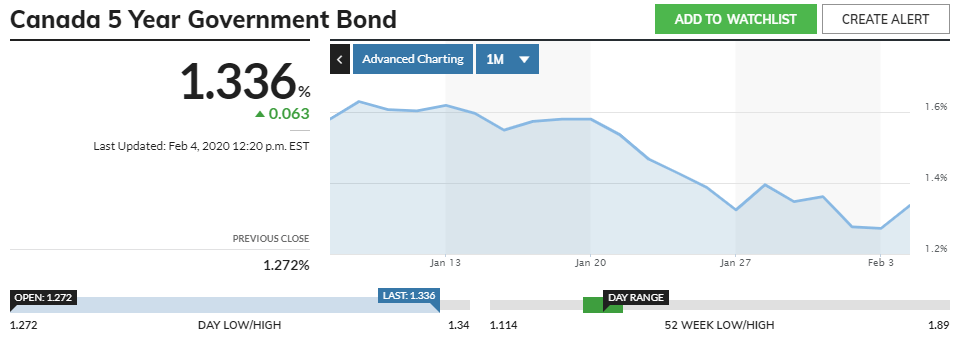TD Posted Rate Lowered to 4.99%
Jackson Middleton • February 10, 2020
Market interest rates have fallen sharply since the coronavirus-led investor flight to the safety of government bonds. The 5-year government bond yield--a harbinger of conventional mortgage rates--now stands at 1.34%, down sharply from the 1.60+% range it was trading in before the virus became global news (see chart below).
This morning, one of the Big-Six banks finally reacted. TD cut its posted 5-year fixed rate to 4.99%.
TD's posted rate had previously been at 5.34%, making this a 36 basis point cut. Other banks had lowered their qualifying rate to 5.19% last July, leading the Bank of Canada to cut its 5-year conventional mortgage rate to 5.19%. This is the qualifying rate under the B-20 rule introduced on January 1, 2018.
Even the regulators have been questioning the efficacy and fairness of using the big-bank posted rate as a qualifying rate for mortgage stress testing.
On January 24, the Assistant Superintendent of OSFI's Regulation Sector, Ben Gully, gave a speech at the C.D. Howe Institute suggesting that the B-20 qualifying mortgage rate historically would be no more than 200 basis points above contract rates. He said that OSFI chose the "best available rate at the time."
He went on to say that for many years, the difference between the benchmark rate and the average contract rate was 200 bps. However, this gap "has been widening more recently, suggesting that the benchmark is less responsive to market changes than when it was first proposed. We are reviewing this aspect of our qualifying rate, as the posted rate is not playing the role that we intended. As always, we will share our results with our federal partners. This will help to inform the advice OSFI might provide to the Minister, as requested in the mandate letter to him. "
By keeping posted rates too high, the Big-Six banks have inflated the qualifying rate, making it more difficult than necessary to pass the stress test to get a mortgage.
While TD's rate cut is welcome news, its posted rate is still too high by historical standards. Given today's average contract rates, the posted rate should be at least 20 bps lower still.
On January 24, the Assistant Superintendent of OSFI's Regulation Sector, Ben Gully, gave a speech at the C.D. Howe Institute suggesting that the B-20 qualifying mortgage rate historically would be no more than 200 basis points above contract rates. He said that OSFI chose the "best available rate at the time."
He went on to say that for many years, the difference between the benchmark rate and the average contract rate was 200 bps. However, this gap "has been widening more recently, suggesting that the benchmark is less responsive to market changes than when it was first proposed. We are reviewing this aspect of our qualifying rate, as the posted rate is not playing the role that we intended. As always, we will share our results with our federal partners. This will help to inform the advice OSFI might provide to the Minister, as requested in the mandate letter to him. "
By keeping posted rates too high, the Big-Six banks have inflated the qualifying rate, making it more difficult than necessary to pass the stress test to get a mortgage.
While TD's rate cut is welcome news, its posted rate is still too high by historical standards. Given today's average contract rates, the posted rate should be at least 20 bps lower still.
Banks have a strong incentive to inflate their posted mortgage rate.
For one thing, they are the basis for the calculation of big-bank mortgage penalties. Also, they are the minimum qualifying rate.
The posted rate does not appropriately reflect the state of the mortgage market as few borrowers would pay this rate.
Interestingly, banks often move this rate in lock-step, or close to it, reflecting their dominant oligopolistic position
in the marketplace.
If a couple of the other big banks follow TD's lead, the Bank of Canada benchmark rate will be below 5% for the first time since January 2018 when the new B-20 rules were adopted. Lowering the stress test rate by 20 bps from 5.19% to 4.99% would require roughly 1.8% less income to qualify for a mortgage on the average Canadian home price (assuming a 20% downpayment), increasing buying power by 2%. This doesn't sound like much, but it can have a meaningful psychological impact on already improving housing markets. The latest CREA data shows that the national average home price surged 9.6% year-over-year in December. A lower stress test rate would make a busy spring housing market even more active.
If a couple of the other big banks follow TD's lead, the Bank of Canada benchmark rate will be below 5% for the first time since January 2018 when the new B-20 rules were adopted. Lowering the stress test rate by 20 bps from 5.19% to 4.99% would require roughly 1.8% less income to qualify for a mortgage on the average Canadian home price (assuming a 20% downpayment), increasing buying power by 2%. This doesn't sound like much, but it can have a meaningful psychological impact on already improving housing markets. The latest CREA data shows that the national average home price surged 9.6% year-over-year in December. A lower stress test rate would make a busy spring housing market even more active.
This article was written by DLC's Chief Economist Dr. Sherry Cooper and originally shared on her newsletter Feb 8th 2020.
RECENT POSTS

Did you know there’s a program that allows you to use your RRSP to help come up with your downpayment to buy a home? It’s called the Home Buyer’s Plan (or HBP for short), and it’s made possible by the government of Canada. While the program is pretty straightforward, there are a few things you need to know. Your first home (with some exceptions) To qualify, you need to be buying your first home. However, when you look into the fine print, you find that technically, you must not have owned a home in the last four years or have lived in a house that your spouse owned in the previous four years. Another exception is for those with a disability or those helping someone with a disability. In this case, you can withdraw from an RRSP for a home purchase at any time. You have to pay back the RRSP You have 15 years to pay back the RRSP, and you start the second year after the withdrawal. While you won’t pay any tax on this particular withdrawal, it does come with some conditions. You’ll have to pay back the total amount you withdrew over 15 years. The CRA will send you an HBP Statement of Account every year to advise how much you owe the RRSP that year. Your repayments will not count as contributions as you’ve already received the tax break from those funds. Access to funds The funds you withdraw from the RRSP must have been there for at least 90 days. You can still technically withdraw the money from your RRSP and use it for your down-payment, but it won’t be tax-deductible and won’t be part of the HBP. You can access up to $35,000 individually or $70,00 per couple through the HBP. Please connect anytime if you’d like to know more about the HBP and how it could work for you as you plan your downpayment. It would be a pleasure to work with you.

If you’re new to the home buying process, it’s easy to get confused by some of the terms used. The purpose of this article is to clear up any confusion between the deposit and downpayment. What is a deposit? The deposit is the money included with a purchase contract as a sign of good faith when you offer to purchase a property. It’s the “consideration” that helps make up the contract and binds you to the agreement. Typically, you include a certified cheque or a bank draft that your real estate brokerage holds while negotiations are finalized when you offer to purchase a property. If your offer is accepted, your deposit is held in your Realtor’s trust account. If your offer is accepted and you commit to buying the property, your deposit is transferred to the lawyer’s trust account and included in your downpayment. If you aren’t able to reach an agreement, the deposit is refunded to you. However, if you commit to buying the property and don’t complete the transaction, your deposit could be forfeit to the seller. Your deposit goes ahead of the downpayment but makes up part of the downpayment. The amount you put forward as a deposit when negotiating the terms of a purchase contract is arbitrary, meaning there is no predefined or standard amount. Instead, it’s best to discuss this with your real estate professional as your deposit can be a negotiating factor in and of itself. A larger deposit may give you a better chance of having your offer accepted in a competitive situation. It also puts you on the hook for more if something changes down the line and you cannot complete the purchase. What is a downpayment? Your downpayment refers to the initial payment you make when buying a property through mortgage financing. In Canada, the minimum downpayment amount is 5%, as lenders can only lend up to 95% of the property’s value. Securing mortgage financing with anything less than 20% down is only made possible through mortgage default insurance. You can source your downpayment from your resources, the sale of a property, an RRSP, a gift from a family member, or borrowed funds. Example scenario Let’s say that you are looking to purchase a property worth $400k. You’re planning on making a downpayment of 10% or $40k. When you make the initial offer to buy the property, you put forward $10k as a deposit your real estate brokerage holds in their trust account. If everything checks out with the home inspection and you’re satisfied with financing, you can remove all conditions. Your $10k deposit is transferred to the lawyer’s trust account, where will add the remaining $30k for the downpayment. With your $40k downpayment made, once you sign the mortgage documents and cover the legal and closing costs, the lender will forward the remaining 90% in the form of a mortgage registered to your title, and you have officially purchased the property! If you have any questions about the difference between the deposit and the downpayment or any other mortgage terms, please connect anytime. It would be a pleasure to work with you.



